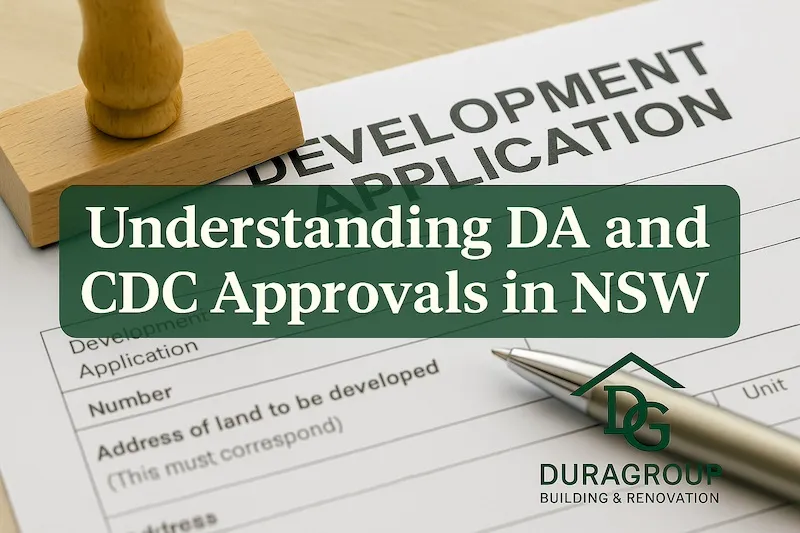When planning your dream home or renovation in New South Wales, understanding the difference between a Development Application (DA) and a Complying Development Certificate (CDC) is critical. These two pathways form the backbone of the construction approval process and determine how quickly and efficiently your project can get off the ground.
At Dura Group Building and Renovations, we help guide our clients through both options to ensure your development meets all NSW planning system requirements, with minimal disruption and unnecessary delays.
DA vs CDC: What’s the Difference?
Both DA and CDC are formal planning pathways to gain approval for building or renovating your property in NSW, but they serve different purposes.
A Development Application (DA) is assessed by your local council, and is typically required for projects that may impact neighbours, streetscape, or the local environment. It involves a more detailed review and can take longer.
A Complying Development Certificate (CDC) is a faster, more streamlined process. It’s issued by a private certifier or council, but only applies to works that strictly comply with a predetermined set of planning controls.
What is a Development Application (DA)?
A Development Application is a formal request to carry out building work that needs consent under the Environmental Planning and Assessment Act 1979. It’s reviewed by your local council and considers how your proposed development affects the neighbourhood, environment, and surrounding land.
Key Aspects:
- Lodged with your local government
- Assessed against Local Environmental Plans (LEPs) and Development Control Plans (DCPs)
- Requires supporting documents such as architectural drawings, site plans, and environmental effects reports
- Usually followed by a construction certificate once approved
The DA process is ideal for customised or complex projects, builds in heritage listed zones, or developments not covered by complying development standards.
What is a Complying Development Certificate (CDC)?
A Complying Development Certificate combines both planning approval and construction approval in one application. It can be approved within 20 days, provided your site and design meet all specific criteria outlined by the NSW Government.
Suitable For:
- Certain home extensions, granny flats, and internal renovations
- Projects that meet strict criteria under the building code and local legislation
- Properties not affected by heritage listings, bushfire zones, or flood-prone land
To obtain a complying development certificate (CDC), you’ll need full architectural plans, site documentation, and a formal CDC submission that demonstrates compliance.
Choosing Between DA and CDC
Choosing between DA vs CDC depends on several factors:
| Consideration | DA | CDC |
|---|---|---|
| Assessment body | Local council | Private certifier or council |
| Approval speed | 6–12 weeks (varies by council) | Within 20 days |
| Complexity | Suits complex or customised developments | Suits projects that strictly comply |
| Documentation | More extensive | More straightforward |
| Design flexibility | High | Limited |
| Cost and time certainty | Less predictable | More predictable |
| Site conditions | Can vary depending on location | Must meet specific criteria |
Why Does This Matter for Your Project?
Choosing the right approval process impacts your timeline, construction costs, and even the design of your dream home. If your land or site has restrictions or unique conditions, the DA process might be unavoidable. On the other hand, if your design fits into standard NSW planning guidelines, a CDC could be the more efficient path.
Working with experienced builders like Dura Group Building and Renovations ensures your project is assessed thoroughly before anything is submitted. We coordinate with architects, private certifiers, and NSW councils to confirm what applies to your property.
Common Triggers That Require a DA Instead of a CDC
You may be required to lodge a development application if:
- The property is heritage listed or in a conservation area
- You’re making changes that affect neighbours or community character
- Your proposed development exceeds standard setbacks, height limits, or floor space ratios
- The land is flood-prone, bushfire-prone, or near protected vegetation
- There are combined planning overlays that require council approvals
In these cases, your builder or architect must assess and prepare comprehensive documentation for council approvals.
Working With Dura Group Building and Renovations
We offer expert guidance on both DA and CDC pathways, and handle all council approvals, compliance checks, and submissions on your behalf. This includes:
- Reviewing site plans and architectural drawings
- Confirming local council regulations and zoning conditions
- Coordinating with private certifiers or councils
- Managing timelines to avoid delays
- Ensuring alignment with environmental planning objectives
Our goal is to make the approval process simple, clear, and efficient so you can move forward with confidence.
Final Thoughts
Whether you proceed with a development application (DA) or a complying development certificate (CDC), the key is knowing which process suits your project, site, and budget. Every property is different, and council rules can vary depending on location and zoning.
If you’re unsure, speak to the team at Dura Group Building and Renovations. We’ll assess your site, guide you through the planning system, and help you get the green light for your dream home, the right way.







